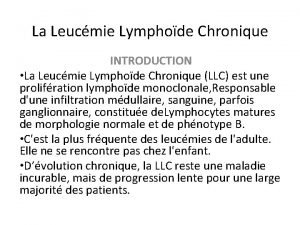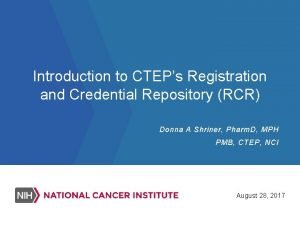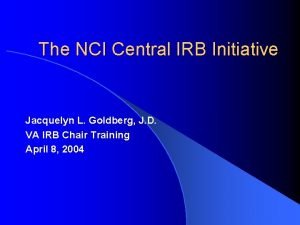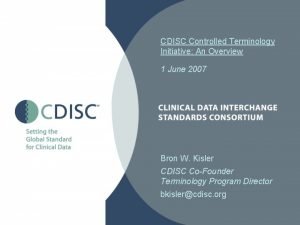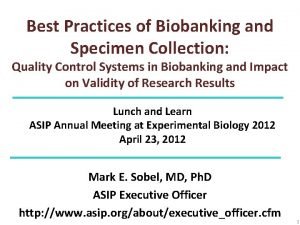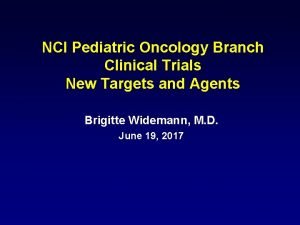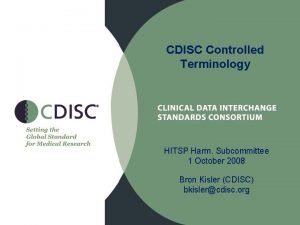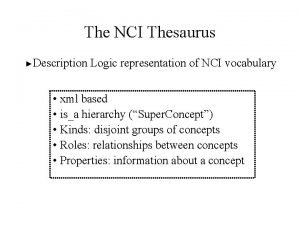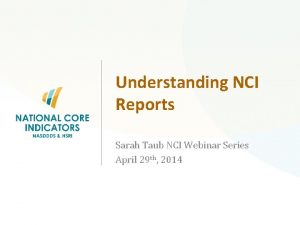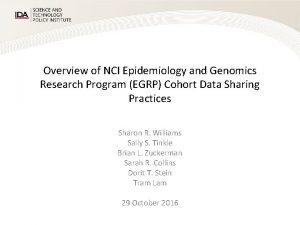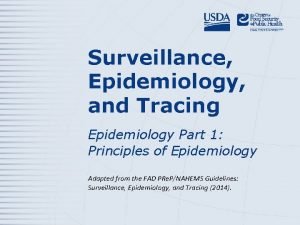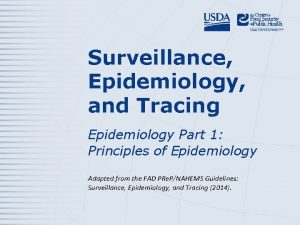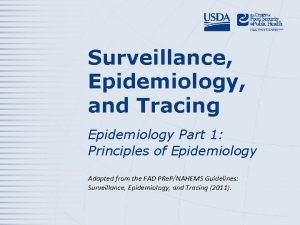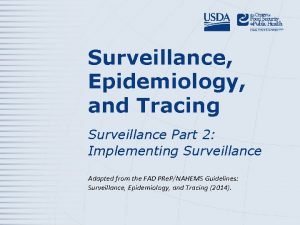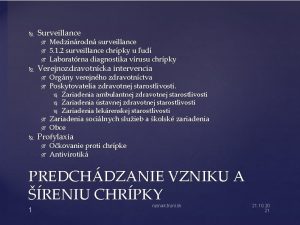Overview of the NCI Surveillance Epidemiology and End























- Slides: 23

Overview of the NCI Surveillance, Epidemiology, and End Results (SEER) Program Paul Fearn, Ph. D, MBA Chief, Surveillance Informatics Branch Surveillance Research Program Division of Cancer Control and Population Sciences ITCR - May 4, 2018

The SEER Program • Funded by NCI to support research on the diagnosis, treatment and outcomes of cancer since 1973 • 16 population-based registries now covering 34% of the US population o Registries collect information on all cancer cases for residents of the state or region o Representing racial and ethnic minorities o Various geographic subgroups • ~550, 000 incident cases annually o Approximately 85% of cases with real-time electronic pathology reporting from laboratories 2

Federally Funded Programs NCI SEER Registries CDC NPCR Registries https: //seer. cancer. gov/report_to_nation/ https: //www. cdc. gov/cancer/npcr/public-use/ https: //seer. cancer. gov/data/ 3

Specific data gaps* being addressed with SEER initiatives • Detailed longitudinal treatment data o First course of therapy collected but limited to generic categorization for systemic therapies (chemo/hormonal/targeted) o No subsequent therapy collected o No access to pharmacy-provided oral therapies • Lack of outcomes other than survival and cause of death o Imperative to understand recurrence • Comprehensive genomic data characterizing the cancer o Only 32 prognostic and predictive biomarkers currently collected o More detailed/comprehensive genomic testing results are necessary to understand characterize each cancer (both at diagnosis and subsequently) *Note: these are gaps for all surveillance systems 5

SEER Big Data Challenges Around 28% of US Population Around 450, 000 new cases per year Around 80% of cases with electronic pathology reports Velocity Over 360 reporting laboratories 1 https: //surveillance. cancer. gov/delay/ Volume Big Data Variety High security and data confidentiality requirements High data quality requirements Veracity 22 -month delay in cancer reporting 1 Heterogeneous data from acquisitions and linkages 6

Solutions in progress at SEER • Efficiently enhance completeness and expand the clinical data collected through • Linkages to capture current and new data items • Cost efficient • Increased accuracy and timeliness (real time data feeds often possible) • Developing tools for automation (NLP/machine learning) • Reducing manual data processing • Increasing consistency and potentially accuracy above human curation • Leveraging these activities through collaborations with external partners both commercial and public • Expanding the SEER program infrastructure for supporting research • Virtual SEER-Linked Biorepository (aka Virtual Tissue Repository) • Virtual Pooled Registry (VPR) 7

Linkages - Radiation Therapy • Currently capture minimal data on radiation therapy is captured only for the initial course • Working with Elekta / Varian to capture selected structured data from their EMRs o Increased detail o Would automatically provide initial and subsequent courses of radiation o Opportunity to identify treatment of recurrent disease • Pilot in process in NY o Northwell hospitals have both Elekta and Varian o Expanding to Seattle-based large Elekta practice o Once successful can scale to broader SEER 8

Linkages – Systemic Therapy • Orally Administered Anti-neoplastics • Traditional Infusion Therapy • Different approaches o Oral treatments provided at pharmacies o Infusions often provided in the outpatient (community oncology practice) setting with limited access by registrars • Current status of linkages with pharmacy chain data o Agreement signed with CVS and Walgreens to receive real time data for all anti-neoplastic therapies o Pilot data received for Walgreens and CVS in Georgia 9

Linkages - Claims • Value of claims for treatment o Standardized format and nomenclature from all providers (ANSI 837) o High degree of accuracy and detail based on CPTs/HCPCs (billing codes) for treatment o Longitudinal data permits assessment of initial and subsequent therapy • SEER- Medicare (ages 65+) o Medicare Claims Data Linked to SEER since early 1990 s o >1600 publications • NCI Cancer “Moonshot” sponsored Claims Workshop in Sept 2017 o Brought together major US Health Insurance Companies : Humana, United (Optum), Aetna, Anthem, Blue Cross, AHIP* o Purpose: seek expansion of linkage of claims from multiple insurers accomplished in Kentucky and Seattle to entire SEER program o Status: working towards agreements with each commercial insurer for data exchange *American Health Insurance Plans- includes HMOs 11

Linkages - Genetic and Genomic Labs o Germline BRCA panels for Breast and Ovarian - 4 commercial labs* representing population testing in California and Georgia • Completed for 2013 -15 data • Goal – link data across all SEER registries for all cancers with BRCA mutation panel testing o Foundation Medicine • Pilot in discussion to link panels with SEER data o Multigene panels • Breast – Genomic Health Incorporated linkage - Oncotype DX 21 and 16 gene assay completed and repeating annually • Prostate – In discussions with commercial companies - Genome. DX, Myriad, GHI (Oncotype Dx Prostate) – Currently unclear benefit of these tests- limited data but tests being used – Linking with registry data and outcomes could provide guidance *Myriad, Ambry, Invitae, Gene. Dx 12

Capturing outcomes other than survival: Recurrence Identifying patients with distant recurrent disease is critical with >16 million cancer survivors for whom we cannot describe the risk of recurrence • Identification of recurrence for the population is complex • It can be diagnosed via multiple methods which vary by: o cancer site o time to recurrence o diagnosing physician type • primary care, oncologist, radiation oncologist, radiologist etc. o diagnostic method (biopsy, imaging, serology) • Accurate measurement of recurrence requires capture of multiple layered, combined data sources and new methods (NLP) to provide comprehensive capture of recurrence(s) 13

Progress Update: Developing systems to support NLP and machine learning • DOE Partnership for Pilot 3 includes 4 registries, 4 DOE labs, NCI SRP and IMS o IRB Approval - 3 registries o DUAs- one registry/4 DOE labs (additional registries DUAs in progress) – Data include: abstracts, path reports, radiology reports, claims, pharmacy data – Participating registries include: Louisiana, Seattle, Kentucky; and Georgia • 4 participating DOE labs (ORNL, LANL, LLNL, ANL) with approved access to Louisiana data (2004 -2017) o Hackathon at ORNL in December 2017 for orientation of DOE labs in use of registry data; next one scheduled for September 2018. • Developed pipeline for scalable annotation of unstructured text and validation of NLP algorithms o Annotation proof-of-concept: 1, 800 pathology reports annotated for ALK, EGFR o Models initially targeting commonly-abstracted data elements (e. g. , primary site, histology, behavior, grade, laterality), distant recurrence, and selected clinical biomarkers o Schema for breast cancer distant recurrence and biomarkers (HER 2, ER, PR) finalized and training materials under development o Colorectal cancer distant recurrence and additional biomarkers (BRAF, KRAS, KI 67, MSI) in the pipeline o Validation of deep learning algorithms for 5 data elements in 2018 o Scale annotation to 10, 000 documents per quarter to support deep learning 14

Progress Update: Unique value in DOE collaboration • Oak Ridge National Lab (ORNL) developed deep learning algorithms to automatically extract 5 key elements from the pathology report in real time o Site, histology, behavior, grade and laterality o Focus on ability to extract data with high degree of accuracy (>97%) where possible AND identify those instances requiring human review and adjudication o Other algorithms developed have trouble with SEER scale (16 registries, >360 path labs), however o Because of volume (450, 000 cases per year) we can use deep learning to build the algorithms o No other algorithms developed incorporate all cancer sites and histologies simultaneously • Los Alamos National Lab (LANL) o Working to develop methods for “Uncertainty Quantification” (UQ) to be integrated with the deep learning algorithms o Permits targeted manual review and curation where necessary to assure highest levels of accuracy for automation • Algorithms will be iteratively improved with registry participation 15

Results – Software Product for SEER and Surveillance Community • • Return API tool to registries and community for integration into work flow and iterative improvement with human adjudication Best performing models with UQ o Identifies path reports in which human review necessary o Packaged into an API in Docker container • Input: …POST-OP DIAGNOSIS: Cancer of cecum… Deep Learning Model API Path Report Input o Path report text • Output: o Predicted annotation o Confidence estimate for prediction • Improve iteratively with registry feedback } 'primary_site': [‘C 189’, [0. 94, 'laterality': [‘ 0’, [99. , …} Predicted annotation and UQ Output 16

NCI-DOE Pilot 3 Scientific Outcomes since 10/2016 2 peer-reviewed publications 7 conference articles and posters 6 presentations CBIIT Speaker Series on Jan 17, 2018 P Fearn, G. D. Tourassi, “Deep Learning Methods for Scalable Information Extraction From Path Reports: An Update from the NCI-DOE Pilot for Cancer Surveillance”, CBIIT Speaker Series, Jan 17, 2018. 17

Enhancing the SEER infrastructure to support recruitment into research studies • SEER registries already support study recruitment using realtime case ascertainment via electronic pathology reports • Centralizing this process through SEER*DMS to make it consistent, enabling recruitment across multiple registries • Efforts focus on • Real-time longitudinal treatment data from linkages • Automated real-time data extraction (via NLP and deep learning) from e-path and other unstructured text documents for tumor characteristics and • Mapping queries between SEER and study criteria 19

SEER-Linked Virtual Bio-Repository Pilot Study • 7 registries funded for pilot of pancreas and breast • Focus on “exceptional” survivors o 431 early stage node-negative breast cancer patients (< 2 yr survival) o 224 pancreatic adenoca long-term survivors (> 5 yr survival) o Pan. Can partnership to support WGS for pancreatic cases and controls o Matched controls for both sets of cancers (matched on a variety of relevant clinical characteristics) • Purpose of Pilot o Assess best practices across multiple registries o Estimate costs of supporting a scaled system o Assess availability of specimens o Understand human subjects/consent as requirements o In addition to primary objectives: – Once completed pilot will provide a well annotated set of cancers with unusual outcomes plus tissue analysis 20 – Data will be available for researchers through db. GAP

Plans to use IMS BSI for VTR Central resource for de-identified abstracts, path reports and path images - support investigator case selection • Ability to search deidentified path reports linked to abstracts • Static Images for QC • Whole Slide Images for digital pathology research 21

SEER-Linked Virtual Bio-Repository: Benefits • Population based – permitting comparison of subsets • Available across a broad spectrum of health care facilities/pathology labs (not just academic centers) • Access to rare cancers and exceptional outcomes • Linked to long term outcomes • Existing annotation with clinical and demographic data • Potential for custom annotation • Renewable with > 450, 000 incident cases annually 22

Virtual Pooled Registry - Background • There is no nationwide registry that could be used to link with a cohort or clinical trial population o The current infrastructure consists of 50+ central (state and regional) registries o Linking for one cohort (Adventist Health) took approximately 3 years and required filling out 47 different IRB applications • The National Cancer Institute and other Federal organizations support linkages in follow-up to many studies including: cohorts, clinical trials and other epidemiologic research o DCCPS alone provides support for follow up of >1. 1 million participants in cohort studies • Conservative cost for follow up estimated to be $2. 2 to $8. 8 million per year o Other divisions support cohort studies, follow up of clinical trial patients etc. 23

Virtual Pooled Registry - Definition What is it? o o o • Permits linkages of patients (cohorts, clinical trials, other research studies) to ALL registries across the US Maintains patient identifiers behind registry firewalls Permits access to appropriately approved investigators Ultimate aims are to develop a system with: o o Automated linkage via an Honest Broker A Centralized and/or templated IRB • • o Eliminating 50+ IRB applications and reviews CIRB will be for minimal risk human subjects research (in DCCPS/SRP) Rapid return of patient information on cancers, survival, cause of death, treatment etc. to the investigator https: //www. naaccr. org/about-vpr-cls/ 24

Data analysis and visualization needs • Visualization and analytics to support linkages of cancer registry with longitudinal treatment data o o o NAACCR formatted central cancer registry data elements Electronic pathology reports and values extracted and coded from reports Genomic testing data (e. g. , Oncotype Dx scores) Longitudinal data (pharmacy, claims, radiation oncology) Longer term interest in mining and integration of EMR data, radiology notes, clinical visit notes • Clinical trial eligibility and real-time case ascertainment through SEER registries • SEER-Linked Virtual Bio-Repository o Pathology imaging analytics • Simulation and predictive modeling (CISNET) 25

THANK YOU 26
 Critères nci llc
Critères nci llc Rcr registration
Rcr registration Cje accounting
Cje accounting Alison lin nih
Alison lin nih Nci central irb
Nci central irb Cdisc sdtm controlled terminology
Cdisc sdtm controlled terminology Nci best practices for biospecimen resources
Nci best practices for biospecimen resources Nccaps nci
Nccaps nci Nf1pn
Nf1pn Nci controlled terminology
Nci controlled terminology Difference between descriptive and analytical epidemiology
Difference between descriptive and analytical epidemiology Advantages and disadvantages of nutritional epidemiology
Advantages and disadvantages of nutritional epidemiology Difference between descriptive and analytical epidemiology
Difference between descriptive and analytical epidemiology Incidence vs prevalence
Incidence vs prevalence Cbic recertification
Cbic recertification Epidemiology person place time
Epidemiology person place time Front end of a compiler
Front end of a compiler Compiler front end vs back end
Compiler front end vs back end Perbedaan or dan rr
Perbedaan or dan rr Logistic regression epidemiology
Logistic regression epidemiology Attack rate formula
Attack rate formula Cross sectional study advantages and disadvantages
Cross sectional study advantages and disadvantages Formula for attack rate
Formula for attack rate Bibliography of epidemiology
Bibliography of epidemiology
